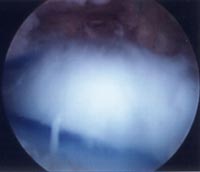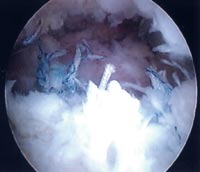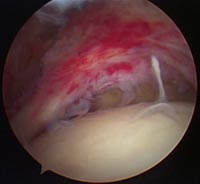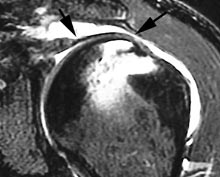Clinicians make arthroscopic application of scaffolds a reality
Two surgeons developed arthroscopic techniques that bring the benefits of tissue scaffolds to rotator cuff tear repair.
|
Orthopedists should expect arthroscopic delivery of biologic scaffolds for rotator cuff repair to be one of the next big developments in shoulder surgery. But, just like their open-surgery counterparts, those scaffolds need to be safe. They also need to be thin and small enough so that they do not overcrowd the surgical field.
Orthopedics Today spoke with two orthopedists who forged the way in this area and are among the first to use bioscaffolds in arthroscopic rotator cuff (RC) repairs: Richard Seldes, MD, and Stephen J. Snyder, MD.
About a year ago, Seldes, director of orthopedics at Forest Hills Hospital, Queens, N.Y., started using Stryker’s single-layer TissueMend implant, which is made of fetal bovine skin. He implanted it in 15 arthroscopic RC repair surgeries. Snyder, a consultant for Wright Medical Technology, manufacturer of the GraftJacket, has used that human skin-based implant in 18 arthroscopic procedures, to date, to repair tears of the RC.
Both surgeons developed special techniques to implant and suture the scaffolds in place through the arthroscope, and have since perfected their techniques. Seldes and Snyder agreed that the day is fast approaching when shoulder arthroscopists will have proven bioscaffold products and appropriate surgical techniques to use.
Where size matters
Seldes trims a 4-cm-by-4-cm piece of TissueMend graft to use in his patients. “I think they’re trying to work on getting a 3-cm-by-3-cm [implant] to make it more cost-effective,” he said in a phone interview.
Snyder whittles down the 5-inch-by-5-inch size GraftJacket scaffold to the size needed. “That’s really an excellent size because we don’t have much waste. We measure our defect arthroscopically with flexible measuring equipment and then cut it to a pattern like a dressmaker does.”
|
From a biological standpoint, using patches makes good sense to both physicians.
“The problem that we still have with RCs, particularly the large, massive tears, is the biology of healing,” Seldes said, discussing challenging situations like tissue atrophy that he regularly sees in his patients’ shoulders.
To help grow reparative new tissue in the area, Seldes turned to the TissueMend product. The arthroscopic technique soon followed. His manuscript describing it was recently accepted for publication by the Journal of Arthroscopy, he told Orthopedics Today.
Carrier potential
Seldes follows his patients with ultrasound and said results are encouraging. He added that anyone who performs many arthroscopic RC repairs should be able to put the 9-cm square implant in arthroscopically. He also highly recommended the scaffold for open procedures.
This scaffold has great potential in light of the increased emphasis on using gene therapy and growth factors to heal RC tears, Seldes said. “In the future, it might be a good carrier for those type of therapies. I definitely see it as part of the armamentarium for treating these very difficult cases.”
|
Snyder, at the Southern California Orthopaedic Institute, analyzed results of canine studies conducted on the GraftJacket implant at the Mayo Clinic in Rochester, Minn., by Scott P. Steinmann, MD, and Howard An, MD. He determined it more than met his needs for a scaffold that promotes rapid revascularization and has a low risk of being rejected by the patient.
“It has to have the strength initially and the ability to attract and house the appropriate stem cells that will then be transformed into fibroblasts, blood vessel channels and the covering — synovial and bursal — on either side that will go on in perpetuity to continue to refresh this tissue and build a new RC. Therein lies the beauty of the GraftJacket,” Snyder said.
Technique evolved
Other key properties of the material include enough elasticity to prevent suture pullout and an ability to encourage ingrowth of blood vessels. “It’s skin,” he said.
A surgical team must implant the device, which takes about three hours. Snyder first puts in special stitches outside and inside the body and then fixes suture anchors to the bone. He then runs the sutures out through the graft and pulls them in to position the implant. Some additional stitches are added at the end around the graft’s edge.
Snyder said it took a while before he felt completely comfortable using the technique. He thinks he can eventually reduce the surgical time to two hours per case, and he plans to train others.
Accelerated rehab
Seldes’ rehabilitation protocol with the patch is conservative and comparable to what he uses for any large RC tear.
He places his patients in immobilizers for about six weeks, only letting them do some gentle pendulum exercises, after which more aggressive therapy begins. Strengthening exercises commence at about three months postop.
|
Two of Snyder’s patients have passed the two-year mark. “The trend with the new grafting materials is that the patients get better so much faster than even the initial patients [did]. I’m now more comfortable moving the patients quicker in the rehab and offering them a lot less misery for their operation because I’ve got such a strong graft,” he said.
According to Snyder, the GraftJacket scaffold is indicated for patients in good health who are nonsmokers, without infection or diabetes. He follows all his patients with MRIs at three months postop to confirm graft incorporation. ot
Dr. Seldes is a consultant to Stryker.
Dr. Snyder is a consultant to Wright Medical Technology.





